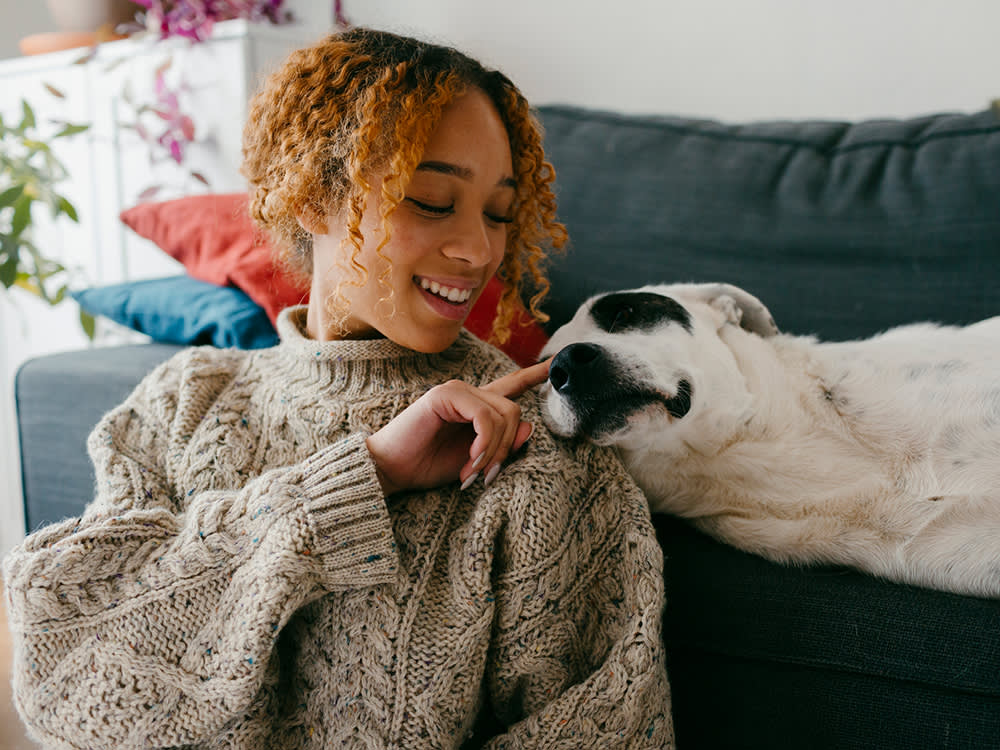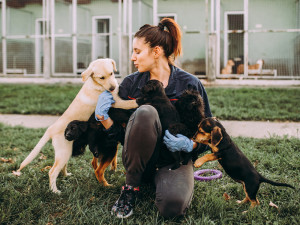Our local shelter put out a call for foster homes for its animals. Four hours after thinking I’d like to help out, I was driving home with an adorable two-year-old mixed-breed dog. Now, what do I do?
Welcoming a new foster dog into your home can be wonderful, frightening, exciting, dizzying, gratifying and overwhelming—sometimes all at the same time. That emotional whiplash is even stronger when the dog arrives with so little warning. The first few days, weeks and even months can be challenging with foster dogs, but there are ways to make it easier on dogs and people alike. Here are a few tips to help you start this journey with your foster dog.
Trick question: All dogs are perfect! But find out which type is the best fit for you.
Get some supplies.
It’s easier to take care of your new foster dog if you have some basic supplies. I recommend a 4- to 6-foot leash, a flat collar, bowls for food and water, dog food, a Kong or similar hollow toy that can be stuffed, a few toys of different types (including chew toys), poop bags, a dog bed (or blankets that can serve as one), and a crate or pen. Those are the key things to have on hand or acquire as soon as possible.
Basic house plan.
As soon as you can, figure out how to use the layout of your home most effectively. Choose spots for the dog bed, crate, food and water bowls, and toys so your foster dog can enjoy these things without being bumped into or surprised. Dogs need to learn where to potty and where to sleep as soon as possible. It is good for your house and good for relieving a dog’s anxiety if they know where to go for these vital functions, so introduce your dog to the bathroom and bedroom right away.
How much do you spend on your pet per year?
Make each introduction positive.
Your foster dog may be overwhelmed by the sudden changes in their life, so focus on making each new experience pleasant and calm. For introductions, that means having them meet every person in your household one at a time in a calm way with no pressure and perhaps some treats or toys if they like them. They should also meet other dogs, cats and any other species in your household one at a time, with a break between each introduction.
Use a leash.
Many foster dogs freak out and run away or resist coming back inside from a fenced yard, a situation that can be made worse by people attempting to catch them. Having a dog on a leash when outside for the first couple days prevents that. It also guarantees that every time they go outside, they have company, and that can help them feel safe and secure.
Get to know your dog.
This process cannot be rushed. In order to start your friendship, you need to spend time with your dog, engaging with them and learning about their likes and dislikes. Figure out what toys (if any) they enjoy and how they like to play, whether that involves fetch, chase or tug. Do some positive training with them, but not with any expectations. Your foster dog may know a lot or they may not even know their name or how to sit when asked. Perhaps they are too overwhelmed to learn much right now. Keep training relaxed and low-key. Consider it a fun way to interact with them rather than a way for them to learn any particular skills. The point is for them to associate you with good things such as treats and toys and love and attention, not for them to excel at obedience.
Stay home.
For now, avoid visits to the veterinarian and groomer if possible. At the very least, your foster dog has experienced many intense changes in a short period of time. Don’t compound that with additional new and potentially unpleasant experiences. Try to stay at home rather than take them to any businesses, however kind they may be to all their furry clients. Your foster dog has enough to adjust to after landing in an unknown household. Obviously, if there is an imminent medical need or your dog’s coat is so matted that it affects their quality of life (restricting their movements or making them uncomfortable), or some other serious issue exists, you may need to take them for help. Otherwise, I recommend waiting a few weeks before visiting any pet professionals.
Be patient.
The most important three words to remember when you are caring for a new foster dog are patience, patience and patience. Do your best to be patient with them and with yourself. You both deserve that grace. Many people (including me!) are helping out by fostering a dog. Good luck and here’s hoping your foster dog finds a forever home soon.







